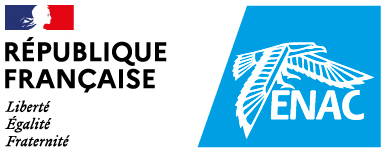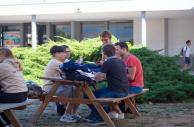Archives Ouvertes HAL
Toutes les publications de l'ENAC en direct.
All ENAC publications.
[hal-05322300] Direct numerical simulation of bubble cavitation at a wall in micro-gravity
Cryogenic tanks used in space applications face challenges due to propellant management, among which is phase change induced by a depressurization. Pool cavitation at the wall in pure methane under micro-gravity conditions is investigated, analyzing its impact on vapor creation and wall heat transfer. A compressible two-phase flow solver, including phase change and conjugate heat transfer, is used. After a validation with available experimental data for single bubble cavitation at the wall in micro-gravity, numerical simulations varying the depressurization amplitude and rate are carried out. Three distinct growth phases are put into evidence: an expansion-controlled...
[hal-05321914] Surrogate Modeling and Explainable Artificial Intelligence for Complex Systems: A Workflow for Automated Simulation Exploration
Complex systems are increasingly explored through simulation-driven engineering workflows that combine physics-based and empirical models with optimization and analytics. Despite their power, these workflows face two central obstacles: (1) high computational cost, since accurate exploration requires many expensive simulator runs; and (2) limited transparency and reliability when decisions rely on opaque blackbox components. We propose a workflow that addresses both challenges by training lightweight emulators on compact designs of experiments that (i) provide fast, low-latency approximations of expensive simulators, (ii) enable rigorous uncertainty quantification, and...
[hal-05317345] FLIGHT ALLOCATION TO EN-ROUTE CONTROLLERS IN THE TBO FRAMEWORK
The present communication deals within the Trajectory Based Operations framework, on the problem of assigning flights to controllers in extended control areas. First, a flight centric complexity metric is used to quantify the interaction between planned flights at the pre-tactical level and an assignment problem solved through an heuristic while leads to the dimensionning of the control task force. Then, to cope with the tactical level, the flight centric complexity metric is modified to take into account trajectories' uncertainty. This allows to propose an on-line allocation scheme of flights to controllers according to their workload and to the estimated traffic...
[hal-05316770] Absolute Environmental Sustainability Assessment of aviation transition scenarios
The aviation sector is currently responsible for 2-3% of annual anthropogenic CO2 emissions and for 5-6% of the climate impact ([1] Référentiel ISAE-SUPAERO Aviation et Climat, 2021). In order to assess its climate footprint over time, the sector and its various stakeholders have developed numerous prospective scenarios (e.g. [2] Dray et al. 2022 and [3] Bergero et al. 2023) incorporating different assumptions about traffic growth, fleet renewal, the introduction of new technologies, and the use of alternative fuels. These scenarios are primarily used to evaluate their potential for decarbonization by comparing them to a "business-as-usual" reference scenario. To evaluate...
[hal-05303006] When Buildings Blur the Lines: Revealing the Hidden Performance Equivalences in MANET Routing Protocols *
The study finds that in urban environments, the performance of non-cross-layer routing protocols (AODV, OLSR, DSDV) becomes nearly identical, contradicting earlier research that ranked their effectiveness. Using a new building-aware loss model in ns-3, we show that realistic urban conditions, unlike traditional open-field models, cause end-to-end delay to increase up to tenfold, with high variability due to unstable links. We also investigate whether adjusting parameters in open-field models could mimic urban connectivity. While this tuning matched some network connectivity metrics, it failed to replicate more complex concepts linked with propagation dynamics of cities...
[hal-05315960] Auditory–tactile presentation accelerates target detection in a multitasking situation
Abstract There is ample evidence from cognitive sciences and neurosciences studies that multisensory stimuli are detected better and faster than their unisensory counterparts. Yet, most of this work has been conducted in settings and with protocols within which participants had the sole detection task to perform. In realistic and complex environments, such as military ones, detection of critical information has to be performed while the operator is concurrently managing several others tasks and processing a vast amount of sensory inputs. To date, it remains to determine whether multisensory benefits for detection hold true in complex multitasking situations. In the...
[hal-05314715] Le compagnonnage dans un écosystème pédagogique inter-universitaire : une opportunité de formation des acteurs ?
Les accompagnateurs pédagogiques ont un rôle crucial dans les écosystèmes de formation et en particulier dans les établissements d’enseignement supérieur, sujets à de nombreuses réformes et évolutions. Le développement professionnel de ces acteurs est donc un sujet majeur qui passe beaucoup par les interactions, souvent informelles, entre pairs via les réseaux organisés localement ou nationalement et les associations internationales. Dans la région Occitanie, une expérimentation de formation pour des ingénieurs et conseillers pédagogiques de plusieurs établissements a été mise en place en intégrant la modalité du compagnonnage. Après 2 ans de fonctionnement du dispositif...








